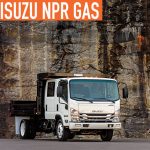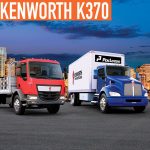It’s mid-August in northern Arizona, and lineman Austin Beckman can feel the electricity in the air. His beard is tingling and his steel-woven safety suit feels like it’s full of hundreds of swarming bees. It’s because of the heat—not from the sun, which is covered today by black, thunderous clouds, but from the giant power lines that are only a few inches away. Coursing with 500,000 volts of electricity, the lines are lethal to the touch if not handled correctly.
Off in the distance, bolts of lightning are striking down. He knows it’s only a matter of time before the rain hits, which could put him in a bad spot, rendering him unable to complete his work in a controlled environment.
He and his partner, Danny Mathis, need to hurry, so he quickly moves the 100-ft high boom of the custom-designed WorkStar® they’re sitting in toward the broken corona ring, a circular piece of metal that lies near the hot end of a string of insulators on the large power line structure. When they get there, Mathis pulls out a two-ft long wand that will allow them to bond themselves to the 500,000-volt lines, and they each take a deep breath.
At a subtle nod from Beckman, Mathis points the bonding wand toward the sky, causing a blue arc of electricity to leap from the power line to the aerial bucket with the sound of a thousand mosquitoes flying into a bug zapper. Beckman and Mathis are now one with the current—“a bird on the wire,” they call it—and can touch the line safely with their hands.
Alas, the rain is beginning to fall steadily. They have to retreat from the energized position, so Beckman quickly retracts the boom. The WorkStar, which was sitting high on its hydrolocks for the job, is able to revert to driving mode in a matter of seconds. Beckman, Mathis, and the rest of the crew pile in.
Now, in the middle of the storm, the WorkStar’s strong frame and six-wheel-drive carries the crew down the plateau, as it crawls over the rugged terrain like a steel-framed beast on the prowl. The crew reaches nearby Highway 87 just as the storm picks up with a loud growl of thunder. Even though the job wasn’t completed, the day is considered a success—everyone remained safe, and the crew’s brand-new WorkStar, which was being used for the first time, performed valiantly.

Featured Image: The crew has to trust that the truck will get them to and from the power structures, which stand out in the remote northern Arizona terrain.
Above: Despite the hazards, Beckman finds his job quite safe, thanks to the training he and his fellow crew members undergo, as well as the advanced equipment they use.
RISKY BUSINESS
Working in tough conditions is something Beckman is used to as a lineman for the Salt River Project, one of the agencies that provides power and water for Arizona. His job, which revolves around making sure SRP’s hundreds of power lines and structures scattered across the state’s backcountry remain intact, comes with a certain amount of risk. “In the back of your mind, there’s the thought that something could go wrong,” he says.
But, despite the hazards, Beckman wouldn’t call the job dangerous. In fact, he thinks it’s quite safe, thanks to the training he and his fellow crew members undergo, as well as the advanced equipment they use.
One of those pieces of equipment is their new WorkStar, designed by SRP engineers and Phoenix dealer RWC International to help them work on “hot,” or energized, power lines safely and efficiently. The truck’s boom is insulated with fiberglass to prevent electric currents from tracking down into its chassis. If a current somehow does make it down, the truck’s custom grounding wires transfer the energy safely into the earth. “When you’re dealing with transmission lines, everything is twice as big—twice as tall,” Beckman says. “You’ve got to trust the equipment and the guys who are there with you.”
The crew also has to trust that the truck will get them to and from the power structures, which stand out in the remote northern Arizona terrain. The WorkStar comes with six-wheel-drive and a 10-liter SCR engine with plenty of horsepower. SRP and RWC spent a year working on the truck together to make sure it would be perfect for the job, just like the many other International trucks the agency owns.

RWC fleet account manager Mary Wilson (standing on the right) says, “At the end of the day, it’s not just about selling a truck. It’s about how we help customers perform their job for the community.”
STRONG PARTNERSHIP
On any given day, there’s a good chance you’ll find RWC Fleet Account Manager Mary Wilson in the gated offices of SRP, located on the outskirts of Phoenix. That’s because she believes constant communication is key, especially when you’re designing and building highly complicated trucks, which RWC does often for SRP. Last year alone, RWC built the agency 47 trucks, including the new WorkStar. Each one went through a rigorous design process to make sure it would be able to complete a specific function.
“We build everything together,” Wilson says. “We try to make it better for them in terms of uptime, the build, and the quality of the machine.”
Take a walk around SRP’s lot, and you’ll find a small army of gleaming WorkStar and DuraStar® vehicles—each with custom-designed modifications like spiraling drills, lift arms, and water sprayers—that help the agency maintain the vast number of facilities it has around the state, including generating stations, reservoirs, and concrete dams. The SRP engineers, who design the trucks using special drawing software, choose to work with International chassis because they’re reliable, affordable, and adaptable, according to Chad Barrett, manager of transportation engineering.
“To be able to get our trucks the way we want them designed, partnering with RWC has been very key,” Barrett says. “For SRP, because of the specific needs of our customers, we don’t have the ability to just buy cookie-cutter trucks.”
One of those customer needs is water—a feature that you can only truly appreciate after standing in the blistering 107-degree Fahrenheit heat for an afternoon. DuraStar trucks are used to maintain the intricate series of canals that line the streets of Phoenix, as well as the reservoirs they lead to.
One truck, for example, is equipped with movable spray cannons and pesticide tanks used to rid canals of weeds and potential fire hazards. Another pumps chemicals into the canals to control aquatic weed growth; it has a specialized cooling system to help the driver stay comfortable during the seven-hour process. These medium-duty trucks, just like the WorkStar, serve as the backbone of SRP’s operation.
“At the end of the day, it’s not just about selling them a truck,” Wilson says. “It’s about how we help them perform their job for the community.”
FOR MORE INFORMATION:
Find out more about the Ford F-150 and other Ford products and services, visit www.ford.com/commercial-trucks.
_______________________________________________________________________
MODERN WORKTRUCK SOLUTIONS: September 2016 ISSUE
Did you enjoy this article?
Subscribe to the FREE Digital Edition of Modern WorkTruck Solutions magazine.
![]()




